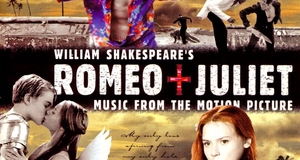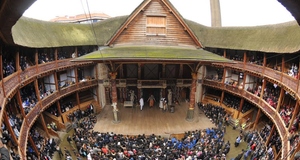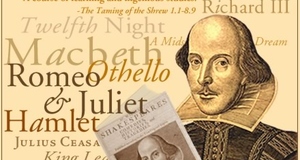James Joyce's "The Dead" Replaying Shakespeare's Romeo and Juliet
By
2010, Vol. 2 No. 11 | pg. 1/2 | »
KEYWORDS:
Burdened by the tomes housing Joyce criticism, new texts that examine “The Dead” risk sinking into a critical vacuum. Peter J. Rabinowitz, in the idiom of reader-response criticism, labels this suction “interpretive vertigo,” while ironically adding to its collective pull.1 The reader experiences Gabriel’s vertiginous sensibility due to the Joyce-specific reading rules of “hyperdense intertextuality” and “infinite etymology” (143). Rabinowitz thus displaces Gabriel’s disorientation at the moment he gazes up the stairwell towards Gretta onto the reader (137). The formalist interpretive protocols identified by Rabinowitz infect Joyce criticism, layering Joyce’s prose with overlapping, contradictory etymological associations due to expectations of perfect unity. Dubious leaps gain traction through the distorting reflection of Joyce’s reputation as “the ultimate literary magpie,” a man who compulsively and brilliantly stockpiled textual references in his later works Ulysses and Finnegan’s Wake (143).2 This Foucauldian author function leads criticism about Joyce’s early work on wild, specious tangents which sometimes follow impotent allusions. These scavenger hunts add nothing fresh to the hunter’s interpretive endeavor. Rather, it distracts from points in the text that can yield substantive insights about Joyce as a young writer when it sacrifices. While critics circumambulate the importance of Romeo and Juliet when they craft their analyses, addressing the structural significance of the Shakespearean tragedy Romeo and Juliet remains an illuminating approach to the 20th century text. Joyce’s “The Dead” rewrites Romeo and Juliet, utilizing the tragedy as a force to structure his story and overcome it. As Vincent John Cheng’s Shakespeare and Joyce: A Study of Finnegans Wake makes clear, Joyce believed he wielded his pen in direct competition with Shakespeare and exhibited a “preoccupation with equating his name with Shakespeare’s” (1). Thus, in contrast to some tangential allusions, the love story Romeo and Juliet directly concerns the pulse of critical discourse.3 As a Shakespearean tragedy explicitly embedded within the Misses Morkans’ domestic environment, the Montague meets Capulet tale informs both the episodes of “The Dead” that incorporate “the staircase and the angle of vision” common to both texts as well as other peripheral scenes (Rabinowitz 143). While “the picture of the balcony scene in Romeo and Juliet…may well be an invitation to apply rules of configuration and prepare ourselves for the intervention of a tragic love plot in the story of Gabriel and Gretta,” this adumbration can simultaneously cue the reader to the drama’s performance within Joyce’s prose. (141).To ignore previous criticism is impossible when tackling Joyce or Shakespeare, let alone both. Surprisingly, few critics provide direct commentary on the Romeo and Juliet relationship with “The Dead.” As one of the handful who does, Daniel R. Schwarz observes that while sending the thematic message of “death as well as frustration of love and hope” that characterize the story’s conclusion, the Shakespearean pieces “are not Irish pictures that Miss Ivors—or followers of the Celtic Renaissance would approve of” but instead those related to Gabriel’s alienated political position (Schwarz 117). Schwarz believes Gabriel to be paralyzed by artistic vision; “(w)hen he sees Gretta (and himself) as a painting, Gabriel is a captive of his visual imagination, which is ironic because he wears spectacles and has difficulty seeing” (113). By ironically naming Gretta’s image at the top of the balcony Distant Music, he functions as a victim of his own art (Joyce 48). Observing The Dubliners as a whole, other critics note that agency may fall upon the bleak Irish nation which jaundices the vision of its inhabitants. Michael Levenson addresses this alternative by abstracting from individual relationships to national power dynamics. He views the Morkan party through the lens of Baudrillard’s simulacra; “Refusing to acknowledge the political provocations that circulate in their festive midst, content to surround themselves with the allure of art and literature, these colonial subjects manufacture a simulacrum of autonomy” (Levenson 173). Thus Levenson tends to downplay the individual in order to explain societal dynamic tension. For Levenson the party’s “reliance on English cultural tradition, neatly captured by the scene from Romeo and Juliet, speaks for the power dynamics of Joyce’s Ireland and the colliding worlds of colonial and postcolonial existence” (174). Problematically, Levenson views the scene and its implications as a neat symbol for his perspective instead of a deeply rooted, invasive Shakespearean influence. Only one critic seems to drive towards a true understanding of the interplay between Joyce and Shakespeare. In her book-length feminist analysis Suspicious Readings of Joyce’s The Dubliners, Margot Norris traces the influence of Romeo and Juliet on “The Dead” more comprehensively than any other critic. Starting her analysis by examining the two Shakespearean paintings hanging in the Morkan hall, Norris applies Adorno’s concept of the culture industry to argue that these pictures, “worked in wools, mindlessly copied without comprehension of [Shakespeare’s] textual or poetic meaning,” serve “to exemplify the bourgeois domestication of tragedy” (227). Monetary value thereby trumps artistic worth. Norris’ argument implies that Gabriel and Gretta reenact versions of Romeo and Juliet with modern burdens rather than revive an Elizabethan rendition; furthermore, to apply a brush stroke of Walter Benjamin’s critical theory, the mechanical reproduction of art sucks the aura from the paintings and leaves them hollow reproductions. To expand this point, Norris notes that Gabriel assumes the lyrical language often identified with Romeo and Juliet while Gretta responds to the gestures of the play in the context of Michael Furey’s unseen corpse. As a result, the Conroy pair produces two variations on the same classic tune; Gabriel envisions himself as a Romeo to Gretta’s Juliet while Gretta sees the dead Michael Furey as her Romeo (228). Norris addresses these points to further a feminist agenda. Looking up the stairwell—in essence a shaft— Gabriel beams through the darkness towards a Female Other. She notes Joyce’s gender divide throughout, claiming Gabriel “plays the balcony scene” with Gretta, “veiling his Juliet’s face…in order to preserve the illusion of her beauty” (227). The verb “play” infantilizes the viewer, depicting a childish Gabriel unaware of the serious implications that characterize his distorted vision (227). She identifies Gabriel’s gaze as an “artistic act” that slowly unravels when he can no longer cast his wife in the role of the unknown, shrouded figure amidst distant darkness (227). But by tailoring her analysis to a feminist frame, her examination of Joyce’s language remains underdeveloped, simplifying the Conroy relationship into one mold which casts Gabriel as misogynist despite conflicting evidence.4 All the critics mentioned pose some persuasive and compelling arguments. Yet every one, as David Leon Higdon suggests, fails to see the larger picture by “concentrating on 618 lines in the encounters and essentially ignoring the structural significances in the remaining 1,042 lines,” myopically ignoring its bulk (180). While clearly important, these scenes monopolize critical attention as the marginalized text remains neglected. Tracing the depths of Romeo and Juliet as a foundational text in the margins of “The Dead” confirms the Western tradition’s influence on Joyce while the tale’s twists indicate his attempt to rewrite both text and tradition. At heart, Romeo and Juliet stages a town-wide family feud and its consequence: the intimate, doomed relationship that awakens Verona to the horrors of its feuding. Revisiting Shakespeare in the 20th Century, “The Dead” similarly explores the tensions within Irish society between supporters of the Celtic Renaissance and West Britons through an individual couple. Tragic reconciliation repeats in the final Dubliners story, as Michael Levenson suggests, when “(a)n Ireland covered in snow…has achieved a unity that its colonial status has long blocked” to become “a storm-driven Ireland flattened into the shape of a nation” (177). Joyce’s writing thereby harnesses the potential in Romeo and Juliet to break down binaries; two worlds mix through marriage—Montague and Capulet anticipates Gabriel and Gretta— but both can find closure and new life only when death paves over entrenched identity clashes. In addition to these larger plot similarities between tales, somewhat elaborated by Norris and others, frequently overlooked intertextual references bolster the cross-genre connection; plunging into these allusive tributaries (in this case, literally paying tribute) seems the only way to map their common source. Juliet uses the world-renowned rose metaphor to claim Romeo “by any other word would smell as sweet,” and Gabriel’s lost letter to Gretta rewrites her words: “Why is it that words like these seem to me so dull and cold? Is it because there is no word tender enough to be your name?” (Shakespeare 129, Joyce 52). While these passages are clearly verbal echoes, Gabriel’s language does not occur within the present like Juliet’s famous monologue. Instead, it plagiarizes the past through the now cliché, commonplace words of stale romantic writing conventions. Shakespeare’s lovers die within the play using defamiliarizing language, but the characters in Joyce speak a “dull and cold” language when they repeat Shakespeare; this dead linguistic art is analogous to the hollow Shakespearean visual reproductions discussed earlier. Shakespeare’s characters may be star-crossed, but Joyce’s characters succumb to a fate worse than death: a culturally and linguistically paralyzed existence. In another often overlooked intertextual relationship, the Capulet and Morkan repasts connect in both general theme and particulars. Capulet stages an annual, elaborate masquerade for his clan that has continued “By’r Lady, thirty years,” while the traditional affair at the Morkan residence, full of characters who seem masked, also started “thirty years ago if it was a day” (Shakespeare 115, Joyce 22). Both dance parties bring political factions into direct contact and conflict. Neither affair erupts into violence or tragedy, but, once the characters find themselves outside of the established ritual, the tensions developed within the walls fester and consume all actors involved. In short, a new community succumbs to the plague shaped by the same societal forces at the roots of Verona and Dublin; this powerful influence silently and insidiously corrodes.Continued on Next Page » Suggested Reading from Inquiries Journal
Inquiries Journal provides undergraduate and graduate students around the world a platform for the wide dissemination of academic work over a range of core disciplines. Representing the work of students from hundreds of institutions around the globe, Inquiries Journal's large database of academic articles is completely free. Learn more | Blog | Submit Latest in Literature |


















